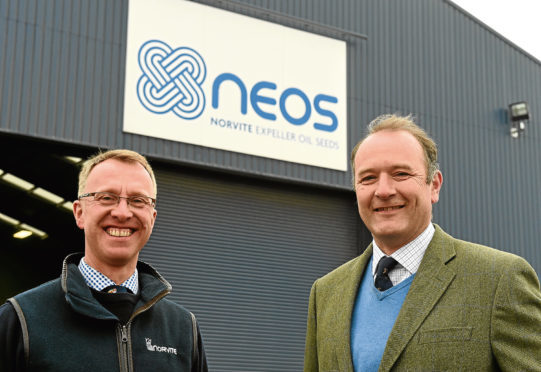Investment in an oilseed rape crushing plant to produce feeds for the agricultural and equine sectors is paying dividends for Scottish animal feed firm Norvite.
The Insch-headquartered company opened its NEOS crushing plant, officially known as Norvite Expeller Oil Seeds, in 2015 following a £600,000 investment.
Last year this was expanded thanks to a further £150,000 of investment and the site now boasts three presses with the ability to process 12,000 tonnes of oilseed rape every year.
The company’s managing director Edward Smith said an estimated 6,000 tonnes of rape will be processed this year and all grain will continue to be sourced from nearby farmers’ co-operative Aberdeen Grain.
He said this would produce 2,000 tonnes of pure cold-pressed rapeseed oil, which the firm markets under the Neoflo brand, and 4,000 tonnes of rapeseed meal which is sold under the Neopro brand.
“The moisture content (of the oilseed rape) is quite critical for our particular process,” said Mr Smith.
“If it’s too wet it’s very hard to filter the oil and if it’s any drier it’s quite hard to crush it.”
He said the optimal moisture content was 7.5%, although anything within 0.5% of this would be acceptable.
“The very wet harvest last year has caused us very significant issues with moisture content,” added Mr Smith.
“It was probably because it was combined quite wet and drying it was much more difficult. It’s something we need to work to resolve this year.”
Technical director David McClelland said the company was pressing the oilseed rape in the same way that extra virgin olive oil is produced, and both the oil and rapemeal products produced in the pressing process have been well received by industry.
He said: “We had a few trials with pedigree sheep and cattle breeders, and the palatability has been well received.
“The oil goes mainly to the pig and poultry market, and there’s also a good equine market for it.”
For laying hens, the addition of rapeseed oil into the diet had a positive impact in terms of egg size, for pigs it offered a good source of energy, and in the equine market a number of leading feed manufacturers were using it in their products, added Mr McClelland.
He said the rapeseed meal was blended into the company’s various feeds for the ruminant market, and more recently a special feed, known as Neolac, has been produced for the dairy market.
The new product, which is being trialled on dairy farms in Ayrshire, is essentially Neopro which has been further processed with an additive to improve its digestability and protein quality.
Mr McClelland said: “From the outset we wanted to substitute the more expensive soyas and rumen protected fats used in dairy diets.
“For dairy cows, energy density and dry matter intake are the key factors. If you don’t produce the energy in their diet, they strip it off their back. The key is keeping them in condition.”
He said feed products such as soya and protected fat supplements are essential tools for giving dairy cows energy, however there is a growing appetite in industry to find alternatives.
Mr Smith said trials had successfully shown that Neolac could replace both soya and rumen protected fats in dairy cow rations, and further trials were under way to look at the product’s impact on milk constituents and yield.
He added: “The fact that we can take increasingly expensive soya, kilo for kilo, and at the same time replace protected fat, there’s clearly a cost saving to the farmer.”
On future plans, Mr Smith said the company wanted to grow sales of all three rapeseed oil products but it would be a case of juggling markets as any increase in oil production would result in increased rapeseed production, and vice-versa.
Mr McClelland said the firm was looking into alternatives to Neopro in its ruminant feeds, as a result of the product being used more and more to produce Neoflo – this included work looking at beans.
Mr Smith added that he was keen to produce organic rapeseed oil and rapemeal in future but getting Scottish organic growers to add oilseed rape to their rotations would be difficult. Mr Smith, who is chairman of the Scottish Organic Producers Association (Sopa), said: “We need organic growers to commit to trying to grow oilseed rape. It’s a niche market. I know it has been done in England and it will take a bit of work but I’m quite sure that it’s possible to do it.
“One of the main worries is that you get volunteers and the growers can’t use any spray to remove them from proceeding crops. But we are pretty sure you could graze it off with sheep.”
He said the company was after an initial 100 tonnes of organic oilseed rape, which it would then be able to crush in its plant into certified products for the organic market.
